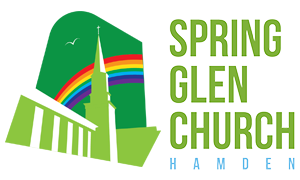Healing Presence

The Rev. Jeff Crews
Sunday, February 12, 2012Text:
Sermon Text
Na-a-man, a great and respected warrior of Aram, now modern-day Syria, had leprosy. In the ancient world, leprosy could mean many different kinds of skin afflictions. He had, as we said with the children earlier, a bad boo-boo. And notice at the beginning of the passage it says that God gave Naaman victory for Aram--so this was a man whom God knew! Then God also helped Naaman figure out where to go to get healing by a message from a young Israelite slave girl. She said, “Go see the prophet in Israel.”
So Naaman heads out with a boat-load of money to buy some healing. Not very different from what we do today, is it? Naaman heads over to see not the prophet as he had been told, but to see the King of Israel who was his sworn enemy. The King obviously must have this healing power, right? No? So, then Naaman goes to Elisha’s house. Notice, to the house, not to Elisha. And Elisha doesn’t even go out to see him—which was a terrible slight to Naaman’s power and dignity. Instead, Elisha sends out a messenger and says “Bathe in the Jordan seven times, and be clean.” And Naaman flew into a rage when the prescribed healing was different than what he had expected. Naaman later had to be convinced by his people to do as Elisha said. And when he did, he was healed.
Five mistakes. Did you hear them? (1) Naaman named the wrong price. He went to the (2) wrong person in the (3) wrong place. He assumed the (4) wrong healing prescription, and Naaman had the (5) wrong attitude. And still, and still, God healed Naaman. Isn’t God amazing?
And then we have a leper in our passage from Mark. This leper knew the (1) right cost, he came to the (2) right place and to the (3) right person in Jesus, he knew the (4) right prescription of faith, and he had the (5) right attitude of trusting. And he was healed. And then, Jesus asked him to please be quiet about the healing so the focus would be on Jesus’ message. But he could not be silent, and told everyone. So God healed the leper, even though the leper did not do as he was told. Two stories where two people ignored what God asked, but God healed them both anyway. Isn’t God amazing?
Will you pray with me? “Dear Great Physician of healing, health and wholeness. Whether we are right or wrong, you can heal us, starting right now. Be to us a healing balm. Cover us with your love, and heal all of our wounds, both inside and outside. Amen.”
The healing miracles of Jesus are tough concepts for modern people. But I am going to ask you to suspend your judgment on healing miracles for just a few moments as we talk about health and healing and wholeness.
Are you healthy right now? Well, that is a relative question, isn’t it? A healthy 90 year-old is different than a healthy 24 year-old. We can be healthy emotionally but not healthy physically. I have known some elders who had perfect spiritual health but whose bodies were breaking down. Let’s ask the question about Naaman. Was Naaman healthy? Sounds like he had everything in life, except he had a skin disease—and it is obvious that really bugged Naaman. Why was this so troubling to him? From the ancient perspective of the Jewish storyteller, this skin disease meant Naaman was ritually unclean. Even if he was a Jew, he could not go into the Temple. Just as a blind Jew was unclean and could not go into the temple. If you think about that a minute, being unhealthy then also meant being ostracized and blocked from participation in the wholeness of community. So, to an ancient Jew, being unhealthy meant not being whole. When Jesus healed skin lesions or blindness or a hemorrhaging women, he really gave them their health ticket to get back into community. Healing wasn’t just about attending to illness, but it was also about restoring wholeness and community.
Let’s look again at what Jesus asked this healed man to do, “See that you say nothing to anyone; but go, show yourself to the priest, and offer for your cleansing what Moses commanded, as a testimony to them.” So this healed person went to the Priest and became ritually clean again, acceptable into the community and whole again, as a testimony, Jesus says. A testimony to what? A testimony that by internal faith and God’s grace he was restored to community and healed. But I am sure you also noticed that first strange command from Jesus. See that you say nothing to anyone. But the healed man ignored this command and freely told everyone. This caused a big hullaballoo —our passage says Jesus could no longer even go into town because the crowds went crazy. He had to stay in the countryside, and even then, people came from every quarter to be healed. And who came to be healed? The crowds mobbed Jesus. Those who were sick, certainly, but also the outcast, those cut off from society, those who were not whole. Jesus’ restoration of health to them meant they had their life in community back. This was the real issue of healing and wholeness. The outer disease was gone, but more importantly, health meant community, belonging and wholeness.
So, what would this kind of healing look like in our modern time? Let me tell you a story. As I was awaiting open-heart valve surgery in 2001, I was terrified. I imagined a surgeons hand’s sawing open my chest, prying me open, taking out my organs, filling my body cavity with icy saltwater to slow my metabolism, connecting me to a heart-lung machine, and then stopping my heart. That’s right: stopping my heart to cut it open. I was terrified. But I told you several weeks ago that the day before surgery the prayer team from my church stopped by and sat with me. And in those quiet minutes, miraculously, I finally stopped worrying, I stopped panicking—I was just present to the moment and let their prayers and love wash over and hold me. I abandoned worry about tomorrow. That was the moment when I was healed. The operation would be hours later—but I was healed when I finally let my faith community love me and hold me and pray for me. That is when I was healed. Look at the man with the skin problems in our passage. When was he healed? When he said to Jesus “If you choose you can make me clean!” The healing began from faith inside the man. The physical repair came from God through Jesus. But the real miracle was on the inside of this man, just as it was on the inside of me before surgery, just as it can be healing presence inside of you. The real healing was when Naaman swallowed his pride and money and power and finally listened to Elisha, and acted in faith. In many ways, Naaman was right—there are many rivers to bathe in that are much nicer than the muddy Jordan. What is so special about washing there? But until Naaman stopped all of the worry and outside frustration and just let go into God’s care, there was no healing.
Now, I get it. Talking about healing puts us modern Christians in a terrible bind. We know that if we ask for healing and then the physical healing does not occur, that it makes us look like our faith wasn’t great enough, or somehow we didn’t believe enough, or worse yet, that God doesn’t care or isn’t listening. But naming how we should be healed is putting God to the test, which always ends badly. Expecting or demanding a physical change puts us at odds with God, instead of walking in faith on God’s side. The healing that came to me before heart surgery was not a “fix me” healing, but a healing of being at one spiritually with God, no matter what actually happened to my body. My healing had nothing to do with my physical heart—it had everything to do with the healing of my soul. I became at peace with whatever life had in store for me—I gained the peace that passes all understanding for a moment in time. I let go of control and worry or need to fix things, and said, “God, whatever happens, I know you are here with me. So now, I let it be.” I was healed on the inside by the care and prayer of those prayerful women. Miraculously, I was filled with the healing presence of God.
So if health means becoming whole in community, then we are, when gathered here, healthy. Together, we are whole. Are we each broken? Yes. Do some of us have disease or illness or stress or troubles? Yes. But together, we are a whole community in Christ. All are welcome here. Whoever, however, wherever and whatever you are, you are welcomed here, to be made whole in healthy holy community. Our Open and Affirming statement is a welcoming health statement: To everyone who is broken, to everyone who needs healing, join us and be healed in community and love. Come and be one of US—healed in community into wholeness.
Ultimately, these stories about healing are about us, being healed on the inside by this fellowship, where we become whole and healthy together. For, you see, [sing] “There is a balm in Spring Glen, to make the wounded whole. There is a balm in Spring Glen, to heal the sin-sick soul.” By grace alone, the Healing Presence of God is in this place, and that healing presence is each one of us, every conversation, every loving hug, every gracious sharing of fellowship. We are a modern every-day healing miracle, and it happens every time we gather. Here, we live and grow together in the Healing Presence of God. Amen.


